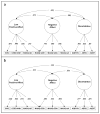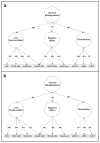Identifying Shared Latent Dimensions of Psychological Symptoms: Implications for the Psychological Correlates of Smoking
- PMID: 26478654
- PMCID: PMC4606875
- DOI: 10.1007/s10862-014-9467-5
Identifying Shared Latent Dimensions of Psychological Symptoms: Implications for the Psychological Correlates of Smoking
Abstract
Shared latent dimensions may account for the co-occurrence of multiple forms of psychological dysfunction. However, this conceptualization has rarely been integrated into the smoking literature, despite high levels of psychological symptoms in smokers. In this study, we used confirmatory factor analysis to compare three models (1-factor, 2-factor [internalizing-externalizing], and 3-factor [low positive affect-negative affect-disinhibition]) of relations among nine measures of affective and behavioral symptoms implicated in smoking spanning depression, anxiety, happiness, anhedonia, ADHD, aggression, and alcohol use disorder symptoms. We then examined associations of scores from each of the manifest scales and the latent factors from the best-fitting model to several smoking characteristics (i.e., experimentation, lifetime established smoking [≥100 cigarettes lifetime], age of smoking onset, cigarettes/day, nicotine dependence, and past nicotine withdrawal). We used two samples: (1) College Students (N =288; mean age =20; 75 % female) and (2) Adult Daily Smokers (N=338; mean age=44; 32 % female). In both samples, the 3-factor model separating latent dimensions of deficient positive affect, negative affect, and disinhibition fit best. In the college students, the disinhibition factor and its respective indicators significantly associated with lifetime smoking. In the daily smokers, low positive and high negative affect factors and their respective indicators positively associated with cigarettes/day and nicotine withdrawal symptom severity. These findings suggest that shared features of psychological symptoms may be parsimonious explanations of how multiple manifestations of psychological dysfunction play a role in smoking. Implications for research and treatment of co-occurring psychological symptoms and smoking are discussed.
Keywords: Disinhibition; Negative affect; Positive affect; Smoking.
Conflict of interest statement
Figures



Similar articles
-
Shared versus specific features of psychological symptoms and cigarettes per day: structural relations and mediation by negative- and positive-reinforcement smoking.J Behav Med. 2015 Apr;38(2):224-36. doi: 10.1007/s10865-014-9597-y. Epub 2014 Sep 18. J Behav Med. 2015. PMID: 25231408 Free PMC article.
-
Psychological symptoms, smoking lapse behavior, and the mediating effects of nicotine withdrawal symptoms: A laboratory study.Psychol Addict Behav. 2015 Mar;29(1):71-81. doi: 10.1037/adb0000029. Epub 2014 Sep 22. Psychol Addict Behav. 2015. PMID: 25243836 Free PMC article.
-
Smoking-related correlates of depressive symptom dimensions in treatment-seeking smokers.Nicotine Tob Res. 2011 Aug;13(8):668-76. doi: 10.1093/ntr/ntr056. Epub 2011 Apr 6. Nicotine Tob Res. 2011. PMID: 21471305 Free PMC article.
-
Applying the tripartite model of anxiety and depression to cigarette smoking: an integrative review.Nicotine Tob Res. 2010 Dec;12(12):1183-94. doi: 10.1093/ntr/ntq174. Epub 2010 Oct 29. Nicotine Tob Res. 2010. PMID: 21036959 Free PMC article. Review.
-
Cigarette-derived nicotine is not a medicine.World J Biol Psychiatry. 2003 Apr;4(2):49-55. doi: 10.3109/15622970309167951. World J Biol Psychiatry. 2003. PMID: 12692774 Review.
Cited by
-
Where do neurodevelopmental conditions fit in transdiagnostic psychiatric frameworks? Incorporating a new neurodevelopmental spectrum.World Psychiatry. 2024 Oct;23(3):333-357. doi: 10.1002/wps.21225. World Psychiatry. 2024. PMID: 39279404 Free PMC article.
-
Positive Affect as a Predictor of Smoking Cessation and Relapse: Does It Offer Unique Predictive Value among Depressive Symptom Domains?Subst Use Misuse. 2018 May 12;53(6):980-988. doi: 10.1080/10826084.2017.1387569. Epub 2017 Nov 21. Subst Use Misuse. 2018. PMID: 29161212 Free PMC article.
-
Latent variable analysis of positive and negative valence processing focused on symptom and behavioral units of analysis in mood and anxiety disorders.J Affect Disord. 2017 Jul;216:17-29. doi: 10.1016/j.jad.2016.12.046. Epub 2017 Jan 11. J Affect Disord. 2017. PMID: 28131628 Free PMC article.
References
-
- Babor TF, Biddle-Higgins JC, Saunders JB, Monteiro MG. AUDIT: The Alcohol Use Disorders Identification Test: Guidelines for Use in Primary Health Care. Geneva, Switzerland: World Health Organization; 2001.
-
- Benjamini Y, Hochberg Y. Controlling the false discovery rate: a practical and powerful approach to multiple testing. Journal of the Royal Statistical Society Series B (Methodological) 1995;57(1):289–300.
Publication types
Grants and funding
LinkOut - more resources
Full Text Sources
Other Literature Sources
Miscellaneous
